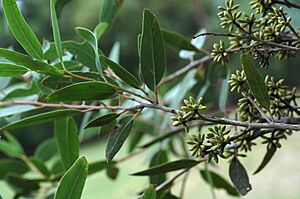Narrow leaved stringybark facts for kids
Quick facts for kids Narrow leaved stringybark |
|
|---|---|
 |
|
| Habit of Eucalyptus sparsifolia | |
| Scientific classification | |
| Genus: |
Eucalyptus
|
| Species: |
sparsifolia
|
The Narrow-leaved Stringybark (scientific name: Eucalyptus sparsifolia) is a type of tree that grows only in New South Wales, Australia. It has bark that looks like strings, shiny green leaves shaped like spears, and small, oval flower buds. When its flowers turn into fruit, they are round.
What it Looks Like
The Narrow-leaved Stringybark is a tree that can grow up to 20 metres (66 ft) tall. It has bark that is grey to reddish-brown and looks like strings.
Leaves
Young trees have shiny green leaves that are a bit hairy. These leaves are wide and shaped like a spear, about 20–50 mm (0.8–2 in) long and 2–4 mm (0.08–0.2 in) wide. The underside of these young leaves is a lighter green.
As the tree gets older, its leaves become narrower and are often a bit curved. They are shiny green on both sides. These adult leaves are about 70–135 mm (2.8–5.3 in) long and 10–22 mm (0.39–0.87 in) wide. Each leaf has a stem called a petiole that is about 10–18 mm (0.39–0.71 in) long.
Flowers and Fruit
The flowers of the Narrow-leaved Stringybark grow in groups, usually with nine to eighteen flowers together. These groups are on a flat or angled stalk called a peduncle, which is about 5–15 mm (0.2–0.6 in) long. Each individual flower sits on a small stem called a pedicel, about 1–3 mm (0.04–0.1 in) long.
The flower buds are green to yellowish and are shaped like an oval or a spindle. They are about 4–6 mm (0.16–0.24 in) long and 2 mm (0.08 in) wide. The top part of the bud, called the operculum, is cone-shaped with a pointed tip. It covers the flower parts inside. The flowers have white stamens, which are the parts that produce pollen.
This tree mainly flowers from September to December. After flowering, the fruit grows. It is a round, slightly flattened capsule (like a small seed pod) that is about 5–8 mm (0.2–0.3 in) long and wide.
How it Got its Name
The Narrow-leaved Stringybark was first officially described in 1934 by a person named William Blakely. He wrote about it in a book called A Key to the Eucalypts.
The scientific name sparsifolia comes from Latin words. "Sparsifolia" means "sparse-leaved," which refers to the tree's top part, called the crown. However, this name might be a bit misleading because the tree isn't always sparse-leaved.
This tree used to be grouped with another type of eucalyptus called E. oblonga. That group included trees with many different leaf widths. Now, trees with wider leaves are considered a different species called E. globoidea.
Where it Grows
The Narrow-leaved Stringybark is very common in forests and woodlands. You can find it in the Sydney area and further inland, as far as the Pilliga forest.
See also
 In Spanish: Corteza fibrosa blanca para niños
In Spanish: Corteza fibrosa blanca para niños


